![[Podcast] Sustainable Restructuring of the Southeast Economic Region (Part 2): Regional Restrictions](/images/upload/img_background/ueh-bg-015747-042423.png)
[Podcast] Sustainable Restructuring of the Southeast Economic Region (Part 2): Regional Restrictions
The Southeast region, making important contributions to the growth and development of the whole country, is facing the challenge of economic recovery and moving towards sustainable development in the long term. Before this problem, University of Economics Ho Chi Minh City (UEH) has been making efforts to contribute to the development of the Region through research and consulting activities. In this article, the author has analyzed the bottlenecks in the development of the Region, from which, proposing structural policies or implemented mid- and long-term restructuring to ensure sustainable development of the Region.
In Part 1 of this article, the author analyzed the important bottlenecks for economic development that the Southeast region (South East) is facing. What are the consequences of these bottlenecks? This Part 2 is going to give the answers.
Economic constraints in the Southeast Region
GRDP growth in the Southeast Region has been slowing down and tends to decrease. So is the growth rate of the Region: in the first decade, the average growth rate of the Region is above 10% and the next decade witnessed a clear downward trend, maintaining an average of 7-8% per year, especially in 2020-2021 due to the massive impact of the Covid-19 epidemic.
One particularly interesting thing to Ho Chi Minh City, as being a leading role in the region with bright spots, listed as the highest proportion of state budget revenue in the region, the highest proportion of private credit mobilization in the Region (accounting for 80% of the Region), has the most technological innovation trend in the Region. To be demonstrated as follows: the GRDP indicator generated per unit of electricity is 20 times higher than that of the regional average; the percentage of trained laborers is the highest in the Region (approximately 40%), the budget expenditure on education is the highest in the Region. The point is that HCMC is, currently, facing the problem of transport infrastructure in terms of being ranked PCI of overall infrastructure, behind Binh Duong Province and Dong Nai Province.
Looking at the evidences of infrastructure overload towards a megacity, it can be identified that the synchronousness of hard infrastructure does limit the inherent potential strengths of HCMC in particular and the Southeast Region in general towards promoting the strengths of the region and other economic regions, it leads to the growth rate of HCMC in particular; on the other hand, the growth rate of the region tends to slow down and go down in the recent years.
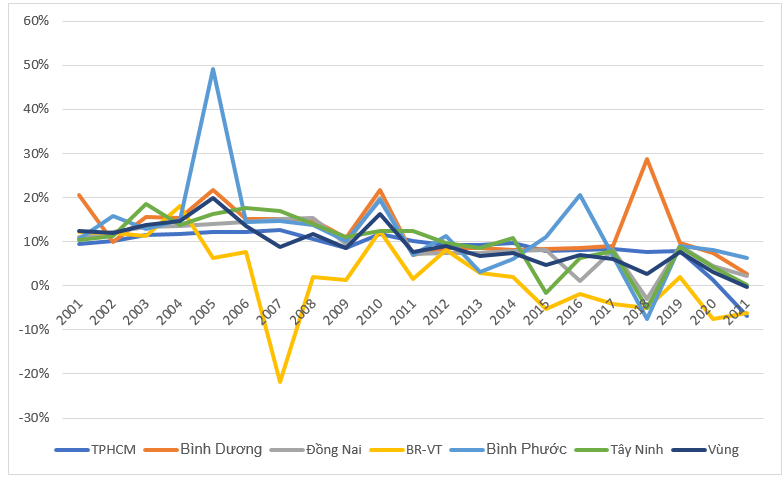
Annual GRDP growth rate. Source: Calculation from GSO data
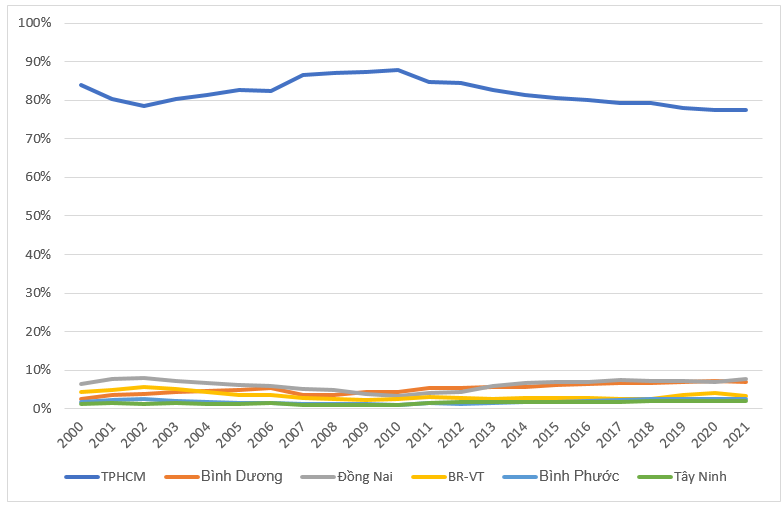
Proportion of private credit mobilization in total regional credit
Source: Calculation from GSO data
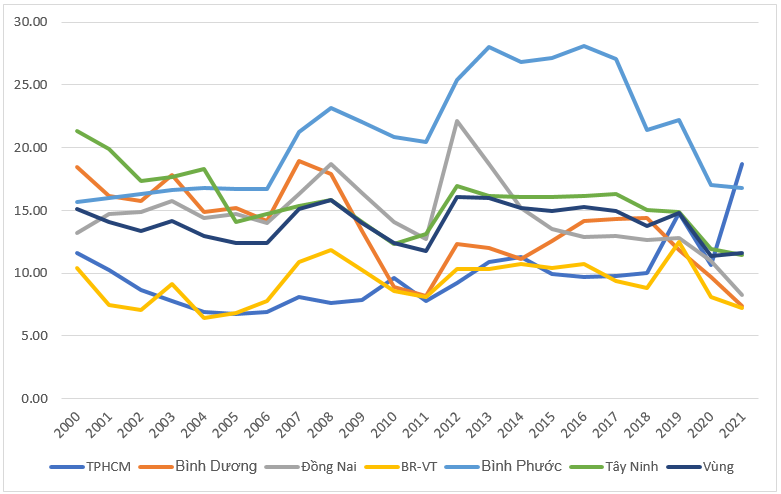
Ratio of state budget spending on education (%).
Source: Calculation from GSO data
Logistics costs are high due to the lack of fully connected logistics and transport infrastructure in the region and the Western economic regions. The region’s economy has a high degree of openness; nevertheless, the transport infrastructure of the Region is not synchronously connected. Especially, Ho Chi Minh City makes up the high contribution to budget revenue whereas the belt-transport systems connecting the Region are not connected completely yet with slow progress.
The Region, occupying a high level of cargo movement through airports and seaports, has a trade openness that has more than doubled in the past two decades and is currently approximately 250% of that of GRDP of the Region (Vietnam’s average is approximately 200% of GDP). Provinces with goods flows from services and industry (listed as Ho Chi Minh City, Binh Duong Province and Dong Nai Province) are being paid more attention. It should be noted that, despite diverse efforts to contribute to the budget, the transport infrastructure of Ho Chi Minh City, a megacity of more than 10 million people, is ranked after Binh Duong Province and Dong Nai Province. Ho Chi Minh City is currently facing congestion and high logistics costs as well as the competition in terms of service and industry tends to go down in the circumstances that the belt system 1 has 10% remaining to be completed and overloaded; the belt system 2 has not been closed due to 6 km remaining; the 90-km-long belt system 3 has not been deployed as well as the 196-km-long belt system 4 has been approved but not fully deployed.
It can be concluded that, with the speed of movement of goods and services serving the Region and import and export in the context that the Region is being weak with regional traffic connections, the connection within the regional logistics system results in Vietnam’s logistics costs. The South in general and the Southeast region in particular are less competitive than other countries in the region; to be more specific: Vietnam logistics costs account for 16.8% of the total value of goods while that of the world average is 10% in 2021).
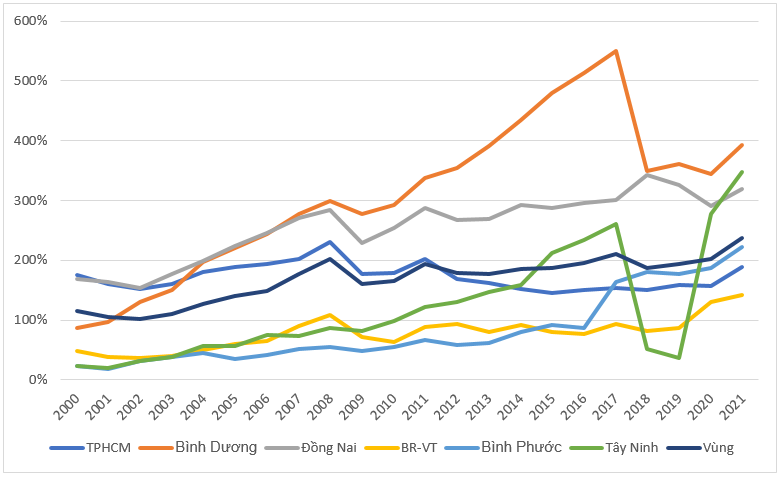
Import-Export ratio to GRDP. Source: Calculation from GSO data
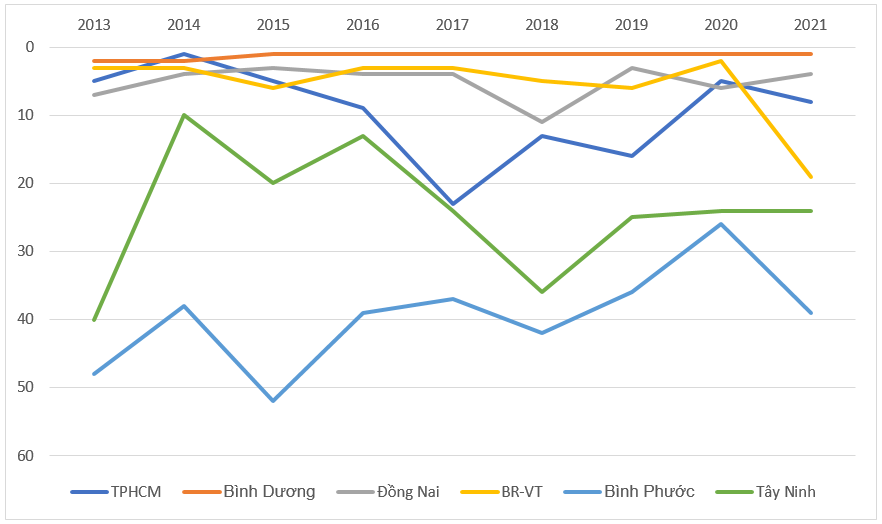
Infrastructure index ranking. Source: PCI
Limiting linkages in the Southeast Region in terms of supply chains
The proportion of agricultural products produced meeting the production standards of biosafety and VietGAP is being limited, compared to the total scale of the Region. The safety standards and the regulations have not been precisely defined; consequently, sustainability in the regional supply chain according to the food safety approach is weak. Currently, Ho Chi Minh City is piloting a unified food safety management model with the focal point being the Management Board of City Food Safety. Meanwhile, other provinces in the Region are organizing food safety management in accordance with a distributed model among provincial management agencies in the three branches of agriculture, health and industry, in which health sector is the focal point.
The production and the processing as well as the direct consumption of agricultural products in the direction of food safety in the Region and for export are still limited due to the low proportion of agricultural products produced according to biosafety standards and VietGAP. Because of the mandatory nature of the law, localities mainly apply biosafety production standards in agriculture and have financial support under the project, especially the support for cooperatives depending on the requirements of the project in accordance with the local resources. Meanwhile, production in compliance with VietGAP standards is not mandatory and only depends on the requirements of the consuming market channel. Although most provinces encourage farmers to join cooperatives to manage safe food production and support VietGAP application, most producers, in reality, are not interested or have little capacity to implement production in accordance with biosafety standards or VietGAP standards.
The certification regarding origin, brands, collective and individual trademarks for providing application solutions for product traceability, issuing barcodes and QR codes for qualified products at the request of production manufacturers is being implemented by the provinces of the Region but not widely. As a result, the Regional supply chain for food products is being not completely sustainable according to the food safety approach. Therefore, the traceability of meat products has not been possible in the traditional distribution channel because it is only traced from the collector towards distribution to wholesale markets. In particular, product traceability is even more difficult when pre-slaughtered livestock products come from many different provinces and cities. The traceability situation is similar for those of other meat and poultry products and vegetables produced by households.
Restrictions on resource management in the Southeast region
The Region and especially the provinces/cities downstream of the river basin will face the problem of water shortage in production and daily life. The water demand from Ho Chi Minh City is the largest in the Region as the population of this megacity is 5 times higher than that of the rest of the provinces in the Region whereas the quality of surface water and groundwater in the Saigon River basin – Dong Nai is declining. In the downstream of Dong Nai River system, saline intrusion is another concerning matter. Monitoring data for the period 2007 - 2014 identified that saline intrusion in Dong Nai Province is showing negative signs: Salinity in Dong Nai River increases markedly, especially from March to May every year. The deeper saltwater intrusion indicates the possibility that Ho Chi Minh City will face the problem of water supply for production and daily life in the near future.
The region, especially Ho Chi Minh City, will face increasingly serious pollution due to domestic wastewater. Dong Nai River basin system currently has 4 cities, 19 districts of Ho Chi Minh City, 8 towns and 85 sub-town. The distribution of urban areas is uneven across the entire basin, most concentrated in the Saigon River basin with 27 urban areas and 5.75 million urban residents. Along with the urbanization and population growth in HCMC and the whole region, the amount of solid waste to be treated and domestic wastewater will continue to increase at a high rate in the up-coming time. Domestic wastewater contains many pollutants to the water of the Saigon River. By 2020, the volume and the amount of pollution flowing into the Saigon River from Ho Chi Minh City and Binh Duong Province is estimated to increase approximately 2 times. This is considered as one of the most basic sources of waste causing water pollution in the basin, especially organic pollution, the pollution caused by nutrients, grease, and surfactant pollution and pathogenic bacteria.
Pollution from toxic agricultural and industrial wastewater that is difficult to be treated harms natural resilience in the long run. Many industrial production groups have high levels of pollution listed as electronics, rubber, plastics, mechanical engineering, chemicals, pesticide production, pulp and paper, textiles and dyes, footwear, leather, metallurgy, and cement. plating, painting, processing agro-forestry products, or food is concentrated in the Southern Key Economic Zone. Industrial wastewater of these industries, containing the diversity of pollutants and toxic, is one source of waste that can cause serious pollution to the water of Saigon River. The pollution degree caused by industrial wastewater is very massive because it is hard to decompose substances as industrial wastewater that contains many toxics; in other words, some substances that can destroy microorganisms and beneficial organisms in the water can cause pollution and environmental pollution as well as rapid degradation of water resources.
The main impact of agricultural activities on river water quality is when the water overflows the fields, carrying the residues of fertilizers and pesticides and entering the river water. Pesticides are highly toxic, have the ability to persist for a long time in water and soil as well as adversely affect aquatic life, human health and food hygiene.
These consequences have been confirmed by the Ministry of Natural Resources and Environment that the Southeast Region is reported to have the following features (Document of Southeast Investment Conference, 2022): the total amount of emissions into the country’s environment besides the air has gradually reaching the safe threshold. The safety of the environmental system affects the living environment and people’s health. The amount of solid waste, CO2 emissions, and wastewater will continue to increase if it continues to develop according to the production-consumption-disposal model; environmental infrastructure system is invested slowly. The results of the survey and the calculation of water balance are forecasted that by 2030 the Southeast region will lack more than 2.5 billion m3, by 2050 the region’s water demand for domestic, urban, industrial, and tourism will tend to tend to the fastest increase in the whole country (approximately 112%). The impacts of climate change and sea level rise increase saltwater intrusion besides the extremely uncertain and irregular weather patterns together with a decrease in dry season rainfall along with a decrease in forest cover, aquatic resources, pollution increases the risk of water security.
Author: Prof. Dr. Nguyen Trong Hoai - Editor-in-chief of Journal of Asian Business and Economic Studies (JABES), University of Economics Ho Chi Minh City.
This is an article in the series of articles spreading research and applied knowledge from UEH with “Research Contribution for All - Nghiên Cứu Vì Cộng Đồng” message, UEH cordially invites Dear readers to look forward to the Knowledge Newsletter DIGITAL ECONOMY #71 [Podcast] Sustainable Restructuring of the Southeast Economic Region (Part 3): Perspective regarding Regional Restructuring.
News, photos: Author, UEH Department of Marketing and Communication
Voice of: Ngọc Quí


![[Podcast] Does the Financial Flexibility Prevent Stock Price Crash Risk during COVID-19 Crisis? Evidence from the Vietnamese Stock Market](https://en.ueh.edu.vn/images/upload/thumbnail/ueh-thumbnail-114718-071624.png)
![[Podcast] An Evaluation Of Two Business English Course Books, Business Partner B1+ Business Partner B2: Students’ And Teachers’ Perspectives](https://en.ueh.edu.vn/images/upload/thumbnail/ueh-thumbnail-113649-071624.png)
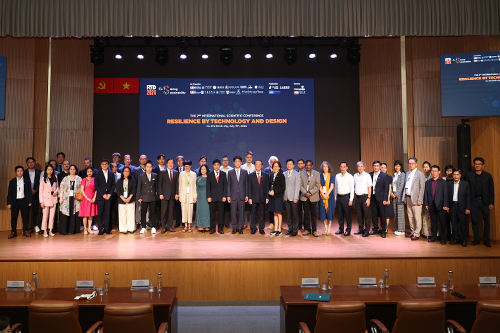
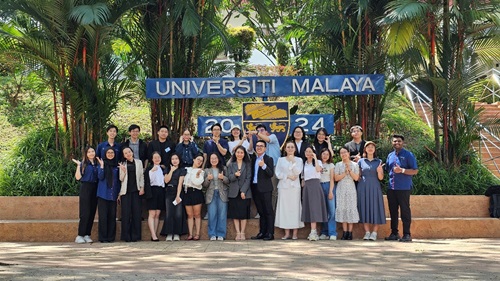
![[Podcast] Latest approaches for sustainable universities](https://en.ueh.edu.vn/images/upload/thumbnail/ueh-thumbnail-042022-071224.png)